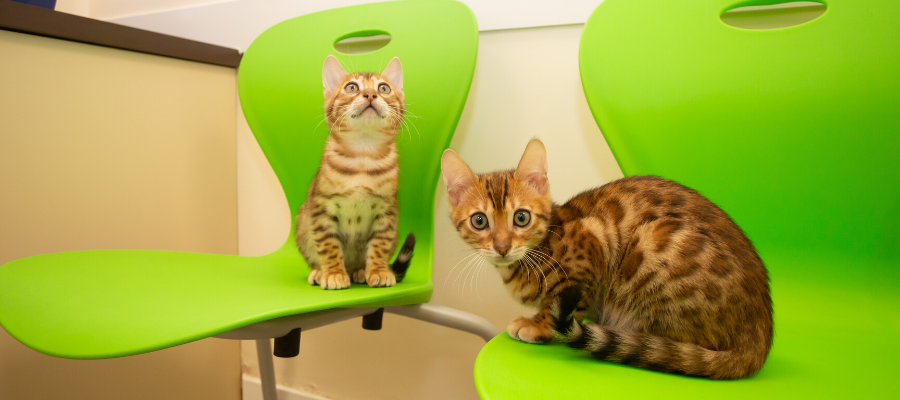 What is the condition?
What is the condition?
The name is a collective term used for several different issues of the bladder and the urethra seen in cats. This condition is most commonly seen in overweight, middle aged, neutered male, indoor cats fed on a dry diet, living in multi-cat households. These cats tend to not urinate as frequently as outdoor cats, resulting in stale urine building up in the bladder for long periods of time, allowing bacteria and crystals to form. Stress can also be a contributing factor to this condition.
FLUTD can also be divided into non-obstructive, or obstructive, where urine cannot be passed from the bladder. Both male and female cats can be affected, although male cats are prone to obstructive disease, due to their narrow urethra being at increased risk of being blocked.
Causes of FLUTD
FLUTD affects around 1-2% of cats a year. Causes include:
- Urethral plugs – where the exit from the bladder to the urethra is blocked with clumps of debris, bladder cells and protein, which combine to form a plug.
- Bladder uroliths (stones)
- Bladder crystals
- Bacterial infection
- Bladder cancer
- Idiopathic cystitis – this means inflammation of the bladder without an underlying cause, despite the well-recognised causes of FLUTD noted above. This is the cause of the problem in 60-70% of cats. See below for more details
Symptoms to look out for
- Straining to pass urine – sometimes crying out in pain.
- More frequently urination or attempting to urinate.
- Urinating in unusual places, outside the litter tray
- Overgrooming around the genitals and lower abdomen
- Changes in behaviour, for example, hiding more, or aggressive behaviour when being handled.
- Blood present in the urine – this can be clots or just pink urine.
- Inability to pass urine – usually seen in male cats (this is an emergency whether your cat is male or female and needs to be treated quickly by your vet)
How is FLUTD diagnosed?
Tests will be run to rule out bladder crystals, infection or cancers before it is diagnosed as idiopathic (unknown cause). The vet will carry out a full examination, checking the bladder and other organs. A urine sample is collected if possible and is analysed for bacteria, blood cells, protein, acidity and concentration.
Treatment is often started based on these results and the symptoms shown. However, if the problem re-occurs, further diagnostics may be needed. An x-ray or ultrasound of the bladder may be needed to identify the root of the problem and look for any abnormalities like a tumour, stones or crystals.
Treatment for obstructive FLUTD
- A blood test will most likely be done to check your cats metabolic state, especially looking at urea, creatinine and potassium levels. These are often elevated and will need to be corrected with intravenous fluid therapy (a drip).
- Your cat will be placed onto intravenous fluids to help rehydrate them and to help flush the urine through the system and increase urine output. This will also help to prevent damage to the kidneys.
- An anaesthetic will be performed to remove the obstruction.
- To dislodge the blockage the urethra is flushed using a catheter. Once the blockage is removed the bladder is flushed using saline to remove any debris that could cause another blockage.
- An indwelling urinary catheter will be placed to allow bladder drainage for the next 48 hours.
- Antibacterial, pain relief and anti-inflammatory medication is given.
Stones and Crystals (Urolithiasis)
Causes
- Urinary tract infection
- High dietary intake of certain minerals
- Systemic disease e.g. liver disease
- Genetic predisposition
There are many different types of crystals (calculi) and stones (uroliths). These are treated with a specific diet which helps to dissolve the crystals and some stones. The diet changes the pH to make the urine more dilute and contains lower levels of dietary minerals that contribute to calculi formation. Although, sometimes stones and crystals must be removed surgically, which is known as a cystotomy. These stones often can’t be dissolved using a diet.
Treatment of non-obstructive FLUTD
Treatment for non-obstructive FLUTD involves long-term management at home.
- Dietary management – Feeding a diet that is low in magnesium and phosphorus. Wet food is preferred as this will increase water intake.
- Weight loss is also encouraged if your cat is overweight.
- Increase water consumption – try different methods as a lot of cats aren’t big drinkers! Try fountains, large shallow bowls and some cats even like drinking from running taps.
- Promote a calm environment as stress can be a contributing factor. Pheromone diffusers or, in some severe cases, medication may be used.
- Provide supplementation in the form of glycosaminoglycan, which promotes the health of the bladder lining that may have been damaged.
- In the case of a bacterial infection, your cat will be provided with antibiotics. Urine samples will be needed to check for any bacteria after treatment.
- Medical therapy is also used to relax the muscles to prevent urethral spasms and anti-inflammatory drugs are used to help with pain and inflammation.
- Regular blood tests and urine samples will be needed to check kidney and bladder function following treatment.
What can I do at home to help?
- Water consumption – use different types of bowls (ceramic, plastic or metal) and put several down in different places in the house or garden to encourage them to drink more. Cats also like drinking from running water, so try using a fountain.
- Adding something tasty to the water like fish stock or chicken flavouring.
- Feeding a wet diet or soaking the dry food will help to increase urination.
- Feeding a specific urinary diet recommended by your vet.
- Allow them to have access to an outdoor space and encourage them to go out.
- Check the location of water and food bowls and litter trays – these should not all be kept next to one another. Preferably they should be out of sight from other cats as this can cause stress to some cats. Don’t place them on the patio, by a window or in the conservatory.
- Know the signs! I f you can pick up on early changes or symptoms then treatment is most likely to be more successful.
Idiopathic Feline Cystitis
What is the condition?
FIC or feline idiopathic cystitis is a common condition in cats, where the bladder lining is inflamed for no apparent underlying cause. It is a very uncomfortable condition and is often seen in younger cats, with episodes usually reducing with age. It can mimic other serious causes for cystitis in cats, for example bladder stones, cancer and urinary tract infections, all of which need to be ruled out before a diagnosis of FIC can be reached.
Causes (idiopathic)
Stress and anxiety are thought to be one of the most common causes, and signs often show after events such as moving house, new cats being adopted, a new baby at home, or being bullied by another cat outside.
Symptoms
- Straining to urinate
- Blood in urine
- Passing frequent but small amounts of urine
- Moving in and out of the litter tray frequently
- Urinating in unusual places around the house
- Licking and over grooming the area
- Being quiet and withdrawn
Diagnosis
The vet will carry out a full body examination and discuss symptoms shown. A urine sample will most likely be collected in practice or at home to rule out bladder crystals and urinary tract infections. An ultrasound scan to check the bladder for signs of cancer, or bladder stones is often recommended. Your vet might also recommend blood tests to check kidney function or an x-ray. A diagnosis of FIC will be reached if the testing shows no signs of underlying disease.
Treatment
In sudden flare ups, the condition is normally treated with an anti-inflammatories for pain relief and to reduce the inflammation of the bladder lining. It is also important to treat the underlying cause of the stress. Some options are listed below:
- Pheromones such as Pet Remedy or Feliway to reduce home stressors such as inter-cat conflict or children.
- Litter tray changes- make sure there are enough litter trays at home (one per cat and one extra) and that they are in private locations where the cats will not be disturbed.
- Bladder supplements will support natural healthy bladder function
- Certain urinary specific diets might be recommended by your vet
- Increase the amount of water your cat drinks by offering water from a water fountain, a tap or a different textured bowl (shallow ceramic bowls are best).
Call us on 01435 864422 if your cat is showing any symptoms of a urinary issue.

